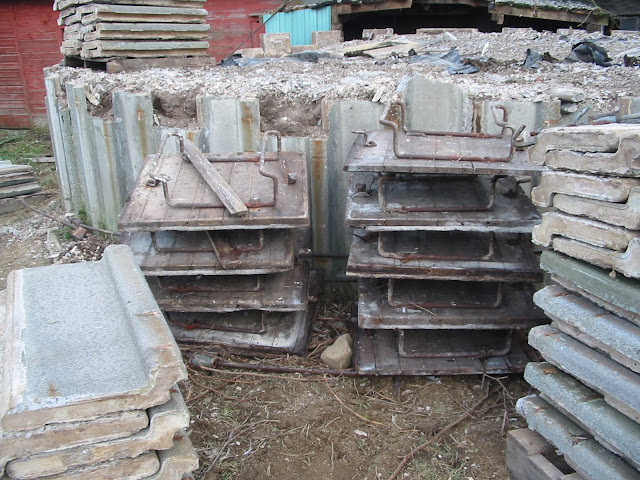The first order of business was to remove the secondary hoops on the lower half of the silo. Many steel hoops completely encircle the silo with extras on the bottom. The lower section bears the brunt of stress when the silo is full. Think of all the downward pressure from the weight above.... the pressure to burst outward is enormous so the steel hoops are essential and they double them up on the lower half of the structure. An empty silo isn't under that pressure so some of them can come off. It also speeds the process if you take some off before getting started.
When the hoops are applied during construction they are tightened in place from both ends at the same time with the help of these clever little connectors. Tighten the two nuts and the hoops contract.
Sections of hoop gathered for transport.
The men quickly began work at the top of the silo - tap the staves with a sledge hammer to break the light mortar seal, wiggle them free and drop them one at a time to the pile of loose dirt below, yelling "Stave!" as each one falls. This view from the back of the silo shows the concrete chute enclosing the ladder used to access the wooden doors in the silo wall. You can just see an empty door frame at the top of the chute. Actually, in an economy of material, the ladder in the chute consists of rungs built into the wooden doors. Each door has two rungs and when they are fastened into the door frames they create the ladder.
Here about five courses have been removed and neatly stacked on pallets for transport. Each stave weighs 72 lbs, so for a silo this size the staves alone weigh 40 tons. Then there is the weight of the unloader and all the steel hoops, the roof, wooden doors......it will take several trips with the big flatbed trailer to move it all to the new "home".
They brought their own skidder with them for moving pallets around.
Tires modified with steel cleats to keep in contact with the ground.......
We kept checking on their progress through the day. Here they are about half done with the first silo. You can see a stave in freefall almost in the middle of the silo. There is a crane arm on the scaffolding (pointing to the left from the top of the silo) and it's used to pull staves up when a silo is being built but for deconstruction they choose to drop the pieces into soft dirt. It's faster. They did use the crane to lower wooden doors and the more fragile concrete door frames. Those are built like a picture frame and wouldn't survive the landing if dropped.
They worked steadily through the day. I had some errands in town and then worked on fleece in the wool shop. Andy spent some time dealing with the corn picker. It will be pressed into service soon and needed bearings and some other parts replaced. Of course you can't just reach in and get that one part, you have to take a whole lot of other parts off first. And remember the order they came off in.
Almost down to the level of the old spoiled silage (plus several inches of pigeon dung. Ick.)
Finished with that silo except for some picking up of small parts. Now they're using the skidder to lift the scaffolding parts into the next silo. They did get that erected inside before they were done. You can count on their quitting time - they have to go home and milk the cows.
Done for the day. Stacks of staves on pallets waiting for transport.
Wooden doors stacked to be loaded. See the two metal rungs?
The road supervisor lent us some orange caution cones to use along the road. The Hoovers were very neat and careful. We barely scraped a wheelbarrow's worth of gravel off the road's edge. Call me goofy (and it wouldn't be the first time. Heh.) but there's something very pleasing about watching a team of men labor well together. No screaming at each other, no confusion, no conflicting directions about how to proceed. They worked quickly, smoothly, neatly and with no casual four-letter language being shouted into the wind (unless it was in Pennsylvania Dutch - I guess I couldnt' say for sure.) Anyway, it was a pleasure to watch them and it gives us good vibes about the silos' next life. The silos do represent the way we lived a large chunk of our lives, especially Andy, and it's hard enough to see them go from the landscape. At least we know they are going to be used by people who live as we lived.
One silo gone except for the base and spoilage that we have to take away. And look at the view that's opening up! :-)
Wow.

















Wow is right, to all of it. I kept thinking as I read this that this is what our culture has lost, the meaning of and ability to do real work.
ReplyDeleteWow. And your new view - wow too :-D.
ReplyDelete. Yes wow. Really enjoying watch this unfold. Thanks
ReplyDeleteI'm thoroughly enjoying these posts...must show Don!
ReplyDeleteadd my wow
ReplyDeleteI thought of that ..men working together...as I read it!
almost spiritual
do they know they are stars of your blog right now?
love the view opening up